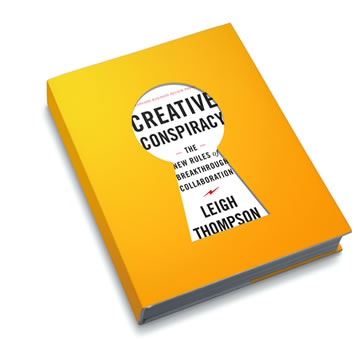Make way for democracy
Leigh Thompson's latest book offers a new approach to creative participation
 |
By Maggie Laubscher
Most teamwork in the office involves a few people leading the charge, while the rest of us listen and nod — or nod off. But, according to Leigh Thompson, with a little forced democracy, it doesn't have to be that way.
In today's Collaboration Economy, the ability to create meaningful partnerships isn't just a bonus — it's essential to progress. Thompson, professor of dispute resolution and organizations, contends that teams can be extremely effective, but "before we can have teams start to work on something, we have to set the stage for them to be working with the best idea."
Otherwise, teams don't stand a chance against the inherent creativity of individuals working independently. In her book Creative Conspiracy: The New Rules of Breakthrough Collaboration, Thompson posits that collaboration is most effective when it is conscious, well mapped out and shared with others.
How do you apply Thompson's theories to your very real, very hectic workplace? First, think of a typical meeting on a typical day at the office.
"Nobody listens," Thompson says. "People drift off. Certain people dominate the meeting. Someone finally starts checking their personal email."
To combat this predictable team experience, Thompson suggests the idea of forced democracy in the workplace. "It shouldn't be just the charismatic, alpha-dominant people who take over things," she says.
To apply forced democracy to your team, Thompson proposes "nominal group technique." Using this method, team members perform solo on a task before pooling the output in the group.
As Thompson notes, you need to know "when to go to the cave and when to go to the commons." The cave, in this case, is equivalent to shutting your office door and working alone, or possibly engaging in "brainwriting."
What’s Thompson reading in her free time?
Spark: The Revolutionary New Science of Exercise and the Brain
by John Ratey and Eric Hagerman (Little, Brown and Company, Jan 2008)
When Callings are Calling: Crafting Work and Leisure in Pursuit of Answered Occupational Callings
by Justin M. Berg, Adam M. Grant and V. Johnson (Organization Science, 2010)
Quiet: The Power of Introverts in a World That Can’t Stop Talking
by Susan Cain (Broadway, Jan 2013)
During brainwriting, team members simultaneously write down their ideas instead of saying them aloud. Without this level of structure and anonymity, Thompson asserts, "people self-censor." To apply this to your next meeting, try passing out index cards and having everyone brainwrite ideas for a set number of minutes. Then, collect the cards and post them on the wall anonymously to avoid self-censoring. Pick the best ideas and go from there.
Thompson's book culls several creative myths to determine how to make teams truly effective and how to enhance a team's creativity rather than suppress it.
"I'm trying to get my leaders and my managers to be much more thoughtful about how they're running their meeting," Thompson says. "Every minute we spend together is a very scarce resource."
Harvard Business Review Press published "Creative Conspiracy" in January 2013.
Kellogg Architectures of Collaboration Initiative: Technological change and globalization enable people and resources to be organized in new ways across time and space. This initiative helps business leaders manage within and across organizations.


